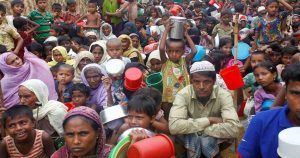Rajshahi Correspondent
Expanded mung-bean farming has opened up the money-making door for more than twenty thousand rural women, including students, as they are harvesting the cash crop in the greater Rajshahi region this season.
Harvest of mung bean is going on in full swing in different areas of the region that sees gradual rise in cultivation of the popular food item.
First time cultivation of BARI mung-6 variety, invented by Bangladesh Agriculture Research Institute (BARI), produced good yield this year.
The mung bean farming has increased in the area this year, keeping trend with previous years. Farmers said that they are able to earn good profits from mung bean production.
Ayesha Aktar, 25, a house wife of Kachhikata village of Boraigram upazila in Natore district said that she was helpless. Now she collects 15 to 30 kilograms of beans from the fields of the farmers and earns Taka 140 to 150 per day.The farmers pay Tk twelve for each kilogram of collected beans, she said.
Rozina Begum, Nargish Ara and some other women of the area who are currently engaged in the same work shared the same story.
School students Meen Aktar, Sabina Rose and Ambiya said they work in the mung bean plot after their studies and earn taka 90 to 100 a day. The money helps them to manage the education expenses as well as lend a helping hand to their poor families.
Farmer Ayez Uddin of Baroipara village in Paba Upazila of Rajshahi district said, he had cultivated Barimug-6 variety of mung beans on his one and a half bigha land this season. He is expecting 14 maunds of pulses from the plot, which can bring a return of about Taka 30 thousand.
The area of coverage of mung beans was 25,000 hectares in Rajshahi, Naogaon, Chapainawabgonj and Natore districts which is projected to grow to 25,006 tons in 2015-16 fiscal year. But, mung bean was cultivated on around 19,500 hectares only in Natore district.
Fazlur Rahman, Additional Director of Department of Agriculture Extension {DAE), said, “The mung bean farming area has been increasing in the region especially in Natore as farmers are earning better returns from it.
Furthermore, mung bean expansion has helped rural women earn a seasonal living as thousands of women are now engaged in farmlands for bean collection.
The seasonal earning helps them to cover their education expenses and help their poor families, he added.
Local agriculture department motivated the farmers to cultivate the highly nutritious and productive Bari mung-6 variety.
The introduction of biotechnology in cultivation of mungbean – may protect 60 per cent production loss, said Dr Shakhawat Hossain, Senior Scientific officer of BARI.
Many farmers have become successful after BARI Mug-6 cultivation in order to enhance cropping intensity in fallow lands of the vast high barind tract.
Quoting the findings of their research work he said mungbean has become resistant to diseases like fungus, virus and pests after introduction of disease resistant gene in it.
There has been an enormous prospect of bringing the huge land under mug bean farming in order to best uses of those alongside increasing cropping intensity amid the current water-stress condition.
After harvesting different rabi crops like wheat, mustard, potato, onion and garlic, above one lakh hectares of high barind land in Rajshahi, Naogaon and Chapainawabgonj districts remain fallow every year.
By dint of enhancing acreage of mug dal, socioeconomic condition of the farmers has started improving coupled with rising soil health.
He referred to various salient features of Mug dal production. He said: “No additional cost for fertilizer, pesticide and irrigation is needed to cultivate this sort-term cash crop”.
Mung bean is a drought tolerant short duration crop which fitted in the drought-prone area’s environment.
So, the farmers are getting high yield and crop residue is added organic matter for soil health development, he pointed out.
Shakhawat Hossain said 1,200 bigha of land were brought under mug bean cultivation this year in preliminary stage.
“We imparted training to 1,200 farmers to elevate their knowledge of how to cultivate the cash crop in modern method,” he said.
Cultivation of Mug dal has been playing a significant role in crop intensity and diversification.
Because, he said, the crop is short-term and it could be cultivated easily on the rice-based cropping pattern.




